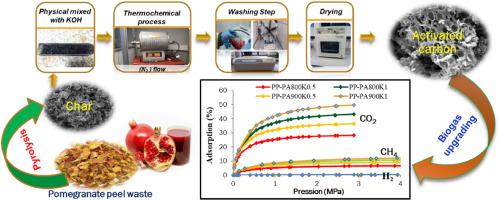当前位置:
X-MOL 学术
›
Biomass Bioenergy
›
论文详情
Our official English website, www.x-mol.net, welcomes your feedback! (Note: you will need to create a separate account there.)
High-pressure gas adsorption on activated carbons from pomegranate peels biochar: A promising approach for biogas purification
Biomass & Bioenergy ( IF 5.8 ) Pub Date : 2024-06-03 , DOI: 10.1016/j.biombioe.2024.107258 W. Saadi , B. Ruiz , S. Najar-Souissi , A. Ouederni , E. Fuente
Biomass & Bioenergy ( IF 5.8 ) Pub Date : 2024-06-03 , DOI: 10.1016/j.biombioe.2024.107258 W. Saadi , B. Ruiz , S. Najar-Souissi , A. Ouederni , E. Fuente

|
Biogas is a promising bioenergy source and its composition is based on methane (55–70% vol) but contains impurities such as CO (30–45% vol). Various technologies are available to purify biogas and produce biomethane that can be injected into the existing natural gas network. In this work, the effectiveness of activated carbons (ACs) obtained by chemical activation from industrial food waste for CO removal by adsorption was investigated. ACs with better textural development were obtained at higher activation temperature and dose of the activating agent (BET surface area and total pore volume up to 1446 m/g and 0.589 cm/g, respectively). The adsorbents exhibited a microporous character (micropore volume up to 0.472 cm/g). The ACs were tested in high-pressure gas adsorption tests (CO, CH and H up to 3, 8 and 4 MPa, respectively). All of them showed high, medium and low selectivity against for the adsorption of CO, CH and H, respectively, although with different efficiencies. The adsorbent obtained under the most aggressive activation conditions (900 °C, 1:1 wt ratio) showed the greatest textural development and the maximum adsorption capacity for CO (at 3 MPa) and CH (at 8 MPa) (495 mgCO/g and 126 mgCH/g). Despite the porosity of the materials, all showed a very low affinity for hydrogen adsorption at 4 MPa (up to 3.71 mgH/g). Taking the above into account, these activated carbons could be used in the purification of biogas and in the separation of CO/H mixtures to produce pure H and obtain hydrogen-free CO for capture and storage.
中文翻译:

石榴皮生物炭活性炭上的高压气体吸附:一种有前途的沼气净化方法
沼气是一种很有前途的生物能源,其成分以甲烷(55-70% 体积)为基础,但含有二氧化碳(30-45% 体积)等杂质。有多种技术可用于净化沼气并生产可注入现有天然气网络的生物甲烷。在这项工作中,研究了通过化学活化从工业食品垃圾中获得的活性炭(AC)通过吸附去除二氧化碳的有效性。在较高的活化温度和活化剂剂量下获得了具有更好结构的活性炭(BET 表面积和总孔体积分别高达 1446 m/g 和 0.589 cm/g)。吸附剂表现出微孔特性(微孔体积高达 0.472 cm/g)。这些活性炭在高压气体吸附测试中进行了测试(CO、CH 和 H 分别高达 3、8 和 4 MPa)。尽管效率不同,但它们对 CO、CH 和 H 的吸附分别表现出高、中和低的选择性。在最剧烈的活化条件(900 °C,1:1 重量比)下获得的吸附剂表现出最大的结构发展和对 CO(3 MPa)和 CH(8 MPa)的最大吸附容量(495 mgCO/g 和126 毫克CH/克)。尽管材料具有孔隙率,但所有材料在 4 MPa 下都表现出非常低的氢吸附亲和力(高达 3.71 mgH/g)。考虑到上述因素,这些活性炭可用于沼气的净化和CO/H混合物的分离,以产生纯H并获得无氢的CO以用于捕获和储存。
更新日期:2024-06-03
中文翻译:

石榴皮生物炭活性炭上的高压气体吸附:一种有前途的沼气净化方法
沼气是一种很有前途的生物能源,其成分以甲烷(55-70% 体积)为基础,但含有二氧化碳(30-45% 体积)等杂质。有多种技术可用于净化沼气并生产可注入现有天然气网络的生物甲烷。在这项工作中,研究了通过化学活化从工业食品垃圾中获得的活性炭(AC)通过吸附去除二氧化碳的有效性。在较高的活化温度和活化剂剂量下获得了具有更好结构的活性炭(BET 表面积和总孔体积分别高达 1446 m/g 和 0.589 cm/g)。吸附剂表现出微孔特性(微孔体积高达 0.472 cm/g)。这些活性炭在高压气体吸附测试中进行了测试(CO、CH 和 H 分别高达 3、8 和 4 MPa)。尽管效率不同,但它们对 CO、CH 和 H 的吸附分别表现出高、中和低的选择性。在最剧烈的活化条件(900 °C,1:1 重量比)下获得的吸附剂表现出最大的结构发展和对 CO(3 MPa)和 CH(8 MPa)的最大吸附容量(495 mgCO/g 和126 毫克CH/克)。尽管材料具有孔隙率,但所有材料在 4 MPa 下都表现出非常低的氢吸附亲和力(高达 3.71 mgH/g)。考虑到上述因素,这些活性炭可用于沼气的净化和CO/H混合物的分离,以产生纯H并获得无氢的CO以用于捕获和储存。
















































 京公网安备 11010802027423号
京公网安备 11010802027423号